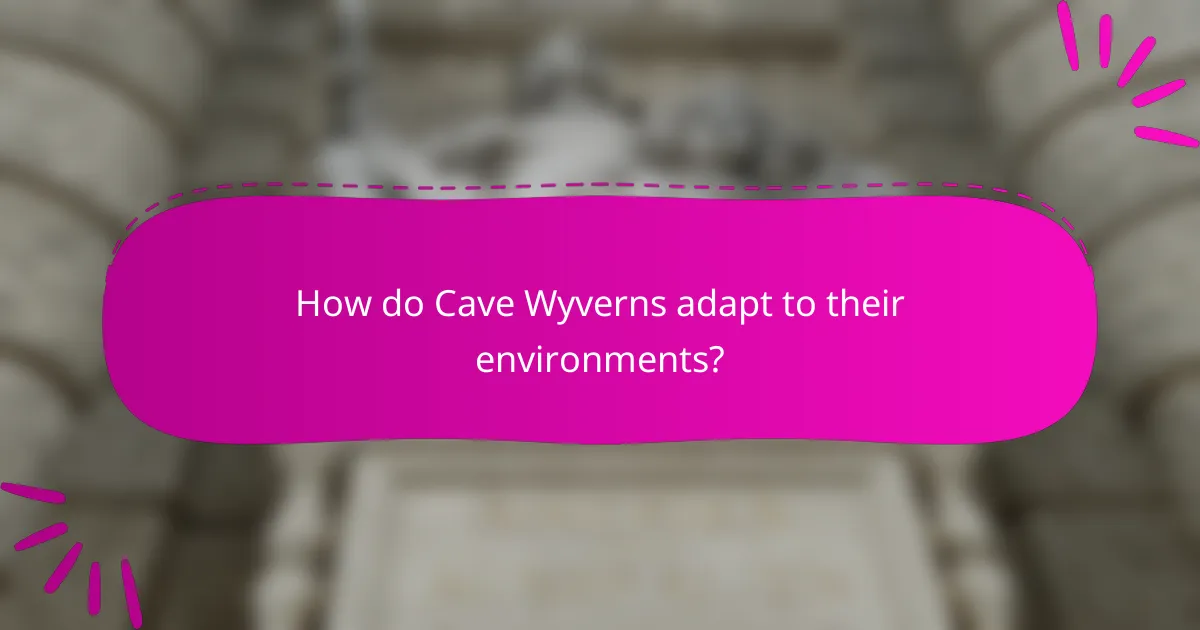Cave Wyverns are fascinating creatures adapted to thrive in dark, subterranean environments. Their unique habitats, characterized by complex cave systems, provide stable temperatures and specialized ecosystems essential for their survival. Equipped with dark vision, these wyverns can navigate effectively through the low-light conditions of their underground realms, making them adept explorers of their shadowy world.

How to navigate subterranean habitats of Cave Wyverns?
Navigating the subterranean habitats of Cave Wyverns requires a combination of specialized gear, effective mapping techniques, and local knowledge. Understanding these elements can significantly enhance your exploration and safety in these dark environments.
Use of specialized gear
Specialized gear is essential for navigating the dark and often treacherous habitats of Cave Wyverns. Equip yourself with high-quality headlamps or lanterns that provide bright, focused light to illuminate your path. Additionally, sturdy climbing gear, such as harnesses and ropes, can help you traverse vertical drops and rocky terrain safely.
Consider using night vision goggles or thermal imaging devices to enhance your visibility in complete darkness. These tools can help you spot Cave Wyverns from a distance, allowing for safer navigation and observation.
Mapping techniques
Effective mapping techniques are crucial for navigating the complex networks of caves inhabited by Cave Wyverns. Start by creating a rough sketch of the cave layout as you explore, noting key features such as entrances, exits, and any notable landmarks. This will help you avoid getting lost in the labyrinthine passages.
Utilize digital mapping tools or apps designed for cave exploration, which can provide real-time tracking and detailed topographical information. These resources can help you plan your route and identify areas where Cave Wyverns are likely to be found.
Local guides and resources
Engaging local guides can greatly enhance your understanding of Cave Wyverns and their habitats. Experienced guides often have extensive knowledge of the cave systems and can provide valuable insights into safe navigation and the behavior of these creatures. Look for guides who specialize in cave exploration or wildlife observation.
Additionally, consult local resources such as wildlife organizations or caving clubs that may offer maps, safety tips, and information on recent sightings of Cave Wyverns. These resources can help you prepare adequately and increase your chances of a successful exploration.

What is dark vision in Cave Wyverns?
Dark vision in Cave Wyverns refers to their ability to see in low-light conditions, allowing them to navigate effectively through subterranean environments. This adaptation is crucial for survival in their unique habitats, where light is minimal or absent.
Definition of dark vision
Dark vision is a biological trait that enables certain creatures, including Cave Wyverns, to perceive their surroundings in darkness. This capability allows them to detect shapes, movements, and even colors in dimly lit areas, enhancing their hunting and navigation skills.
In Cave Wyverns, dark vision typically allows them to see in conditions where light levels are extremely low, often down to a few lumens. This adaptation is critical for their survival in caves and other subterranean habitats.
Benefits for survival
The primary benefit of dark vision for Cave Wyverns is improved navigation in their dark habitats. This ability helps them avoid obstacles, find prey, and escape from predators, significantly increasing their chances of survival.
Additionally, dark vision allows these wyverns to hunt more effectively at night or in dark environments, where their prey may be less aware of their presence. This advantage can lead to higher success rates in feeding and breeding.
Comparison with other creatures
Compared to other creatures with similar adaptations, Cave Wyverns possess a more refined dark vision. For instance, many mammals have limited night vision, while Cave Wyverns can see clearly in near-total darkness.
In contrast, some reptiles and amphibians also have dark vision, but their range and clarity may not match that of the Cave Wyvern. This distinction highlights the wyvern’s specialized adaptation to its unique subterranean lifestyle.

What unique habitats do Cave Wyverns inhabit?
Cave Wyverns thrive in dark, subterranean environments characterized by complex cave systems. These habitats provide essential conditions for their survival, including stable temperatures and unique ecosystems that support their dietary needs.
Characteristics of subterranean environments
Subterranean environments are typically marked by low light levels, high humidity, and stable temperatures, often ranging from 10°C to 15°C. The absence of sunlight leads to a lack of photosynthetic plants, creating a distinct ecological balance. These conditions foster the development of specialized adaptations in the organisms that inhabit them.
Cave systems often feature diverse geological formations such as stalactites and stalagmites, which can influence the movement and behavior of Cave Wyverns. The intricate layout of tunnels and chambers can serve as both shelter and hunting grounds.
Common flora and fauna
The flora in cave habitats is limited, primarily consisting of fungi, mosses, and certain hardy plants that can survive in low-light conditions. These organisms play a crucial role in the cave ecosystem, providing food and habitat for various species.
Fauna includes specialized creatures such as cave-dwelling insects, bats, and other small mammals that have adapted to the darkness. These animals often serve as prey for Cave Wyverns, creating a balanced food web within the subterranean environment.
Geographical distribution
Cave Wyverns are predominantly found in regions with extensive limestone formations, which are conducive to cave development. This includes areas like the Appalachian Mountains in the United States and various karst landscapes in Europe and Southeast Asia.
Their distribution is often limited to specific cave systems, where they can find adequate food sources and suitable breeding conditions. Conservation efforts are essential in these regions to protect their habitats from human encroachment and environmental changes.

What equipment is essential for exploring Cave Wyvern habitats?
Exploring Cave Wyvern habitats requires specialized equipment to navigate the dark and complex subterranean environments. Essential tools include reliable navigation aids and safety gear to ensure a secure and effective exploration experience.
Recommended navigation tools
For navigating Cave Wyvern habitats, a combination of traditional and modern tools is crucial. A high-quality compass and detailed topographic maps can help maintain orientation in the absence of light. Additionally, GPS devices designed for underground use can provide accurate positioning, though they may have limited functionality in deep caves.
Consider using headlamps with adjustable brightness settings to illuminate paths without losing night vision. Some explorers also benefit from using handheld laser rangefinders to measure distances in dark environments. Always ensure your navigation tools are durable and water-resistant to withstand the cave’s conditions.
Safety gear for subterranean exploration
Safety gear is paramount when exploring Cave Wyvern habitats. A sturdy helmet with a mounted light is essential to protect against falling debris and to provide illumination. Additionally, wearing durable, waterproof clothing can help keep you dry and comfortable in the often damp cave environment.
Invest in a reliable harness and climbing gear if your exploration involves vertical ascents or descents. A first aid kit tailored for cave exploration is also advisable, including items like bandages, antiseptics, and emergency communication devices. Always check local regulations regarding safety equipment to ensure compliance with any specific requirements for subterranean exploration.

How do Cave Wyverns adapt to their environments?
Cave Wyverns have developed unique adaptations that enable them to thrive in subterranean habitats. These adaptations include specialized behaviors and physiological traits that enhance their survival in dark, confined spaces.
Behavioral adaptations
Cave Wyverns exhibit distinct behavioral adaptations that help them navigate their dark environments. They rely heavily on echolocation to detect obstacles and prey, emitting sounds that bounce off surfaces to create a mental map of their surroundings. This ability allows them to move swiftly and accurately in total darkness.
Additionally, these creatures often exhibit nocturnal activity patterns, which align with their habitat’s natural light conditions. By being active during the night, they can avoid potential predators and maximize their hunting efficiency.
Physiological traits
The physiological traits of Cave Wyverns are tailored for life in low-light conditions. They possess highly developed dark vision, allowing them to see in near-complete darkness. Their large, sensitive eyes can detect even the faintest light, providing them with a significant advantage in their subterranean habitats.
Moreover, Cave Wyverns have adapted their body structure to navigate tight spaces. Their elongated bodies and flexible wings enable them to maneuver through narrow tunnels and caverns. This physical adaptability is crucial for both hunting and avoiding threats in their complex underground environments.

What are the ecological roles of Cave Wyverns?
Cave Wyverns play crucial ecological roles in their subterranean habitats by influencing nutrient cycling and maintaining the balance of local ecosystems. Their unique adaptations allow them to thrive in dark environments, impacting both the flora and fauna of these regions.
Impact on local ecosystems
Cave Wyverns contribute significantly to the nutrient dynamics of underground ecosystems. By preying on various cave-dwelling organisms, they help regulate populations of insects and other small creatures, preventing overpopulation and promoting biodiversity.
Additionally, their waste products serve as a natural fertilizer, enriching the soil and supporting the growth of specialized cave flora. This interaction fosters a unique ecosystem where both plant and animal life can flourish despite the challenging conditions of darkness.
Interactions with other species
Cave Wyverns have complex relationships with other species in their habitats. They often share their environment with various insects, fungi, and even other predators, creating a web of interactions that can influence survival strategies and reproductive behaviors.
For example, some smaller species may rely on the presence of Cave Wyverns to control pest populations, while others may adapt to avoid competition by altering their foraging patterns. These interactions highlight the importance of Cave Wyverns in maintaining ecological balance within subterranean environments.










